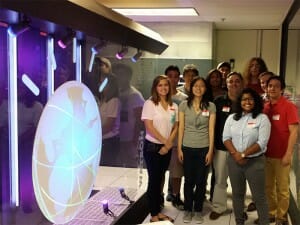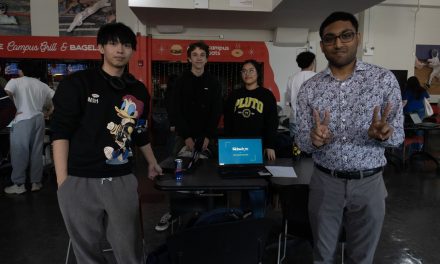
Students and mentors participating with the College of Staten Island's Research Experience for Undergraduates (REU) program visited the IBM-Watson research facility in Yorktown Heights, NY. The Super-Computer (in blue on the left) is named "Watson," and is most popularly known as the computer that won on Jeopardy back in 2011.
The Research Experiences for Undergraduates (REU) program at the College of Staten Island hosted eight college undergraduates from across the country this past summer. For ten weeks, participants lived in Dolphin Cove and performed research in areas of national importance with computer science faculty mentors from CSI, on topics such as: Computational Methods in High Performance Computing with applications to Graph Theory, Network Reliability, Cryptography, Network Security, Wireless ad-hoc and Sensor Networks, Large-scale and Complex System Modeling and Simulation, and Image Processing.
Sponsored by the National Science Foundation (NSF) and the Department of Defense (DoD), the program was hosted by the CSI Department of Computer Science in collaboration with The City University of New York Interdisciplinary High Performance Computing Center (IHPCC). A primary goal of the REU is to attract and retain talented students and to prepare them for graduate studies and research careers in computer science or related research fields.
This summer, the first of a three-year of the program at CSI, more than 80 students applied. Eight applicants were accepted and each received a $5,000 stipend, and a package that covered housing costs, meals, and travel expenses. The students attended lectures given by CSI researchers Dr. Anatoly Kuklov from Engineering Science and Physics and Dr. Dan McCloskey from Psychology, as well as researchers from other universities whose activities require high performance computational techniques. Social and scientific field trips were also also scheduled, to sites such as the IBM Thomas J. Watson Research Center in Yorktown Heights.
Participants, who attended the program from June 1st to August 7th, were divided into four groups that worked with their respective mentors on different projects in which the main objectives and results obtained were to be presented at the end of the program. The students were tasked with not only learning theoretical aspects behind their research but also implementing computer applications requiring parallelism, with the help of their CSI faculty mentors and CUNY IHPCC’s research associates, including Dr. Eugene Dzedzits.
The main purpose of the program, according to Dr. Louis Petingi, CSI Professor of Computer Science and REU program lead, was to “expose the students to real research and take on the POV of the researcher.” He also believes that students, should be “on the frontier of knowledge,” meaning, they should not only be asked to study theory but to use that theory to create new and useful applications for our future. The participants produced meaningful research results written-up in a format of technical report and presentation.
Below are three presentations given by REU summer program students:
[youtube]http://www.youtube.com/watch?v=4EfmbtWPGrA[/youtube]“Finding Partial Hash Collisions through Brute Force Parallel Programming” by Vincent (Chuck) Chiriaco (University of North Alabama), Aubrey Franzen (Northern Kentucky University) and Rebecca Thayil (Bryn Mawr College). Project: Cryptography. Mentored by Dr. Xiaowen Zhang.
A cryptographic hash function is used in data integrity check, digital signature, authentication protocol, etc. A hash function compresses an arbitrary length message into a shorter fixed length digest, or hash value (i.e., fingerprint of the message). If two or more messages are hashed to the same or similar digest, we call this a partial collision. If a collision can be easily found, then the data integrity can be violated and digital signature can be easily forged. By brute force method using parallel programming techniques, students systematically find partial hash collisions for a given target message, i.e., finding other messages that have the similar digest as the digest of the target message.
[youtube]http://www.youtube.com/watch?v=iwNbScmUoAA[/youtube]“GPU Acceleration for Digital Holographic Image Reconstruction and Processing” by Danielle Lopez (Rowan University) and Ivan Mazo (Kean University). Project: Image Processing. Mentored by Dr. Shuqun Zhang.
Students use phase shifting holography to record and reconstruct an object and implement image processing algorithms based upon GPU architectures.
[youtube]http://www.youtube.com/watch?v=JRUjSINg6VU[/youtube] “Network Reliability” by Martin Lapinski (CSI’s Macaulay Honors College), Helen Lin (CSI, Computer Science), and Myles McHugh (Kean University). Project: Graph Theory. Mentored by Dr. Louis Petingi.
Students explain how Network Reliability Theory can be used to measure performance objectives of different communication networks (e.g., wireless networks) and how Monte Carlo techniques can be applied to efficiently estimate the reliability using parallel processing on a distributed environment.

![[videos] Summer of Science, Research Experience for Undergraduates](https://csitoday.com/wp-content/uploads/2015/09/REU-watson.jpg)















